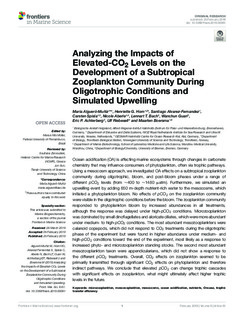| dc.contributor.author | Alguero-Muniz, Maria | |
| dc.contributor.author | Horn, Henriette G. | |
| dc.contributor.author | Alvarez-Fernandez, Santiago | |
| dc.contributor.author | Spisla, Carsten | |
| dc.contributor.author | Aberle-Malzahn, Nicole | |
| dc.contributor.author | Bach, Lennart T. | |
| dc.contributor.author | Guan, Wanchun | |
| dc.contributor.author | Achterberg, Erik P. | |
| dc.contributor.author | Riebesell, Ulf | |
| dc.contributor.author | Boersma, Maarten | |
| dc.date.accessioned | 2020-02-20T09:50:02Z | |
| dc.date.available | 2020-02-20T09:50:02Z | |
| dc.date.created | 2020-01-10T16:07:09Z | |
| dc.date.issued | 2019 | |
| dc.identifier.citation | Frontiers in Marine Science. 2019, 6 (UNSP 61), . | nb_NO |
| dc.identifier.issn | 2296-7745 | |
| dc.identifier.uri | http://hdl.handle.net/11250/2642808 | |
| dc.description.abstract | Ocean acidification (OA) is affecting marine ecosystems through changes in carbonate chemistry that may influence consumers of phytoplankton, often via trophic pathways. Using a mesocosm approach, we investigated OA effects on a subtropical zooplankton community during oligotrophic, bloom, and post-bloom phases under a range of different pCO2 levels (from ∼400 to ∼1480 μatm). Furthermore, we simulated an upwelling event by adding 650 m-depth nutrient-rich water to the mesocosms, which initiated a phytoplankton bloom. No effects of pCO2 on the zooplankton community were visible in the oligotrophic conditions before the bloom. The zooplankton community responded to phytoplankton bloom by increased abundances in all treatments, although the response was delayed under high-pCO2 conditions. Microzooplankton was dominated by small dinoflagellates and aloricate ciliates, which were more abundant under medium- to high-pCO2 conditions. The most abundant mesozooplankters were calanoid copepods, which did not respond to CO2 treatments during the oligotrophic phase of the experiment but were found in higher abundance under medium- and high-pCO2 conditions toward the end of the experiment, most likely as a response to increased phyto- and microzooplankton standing stocks. The second most abundant mesozooplankton taxon were appendicularians, which did not show a response to the different pCO2 treatments. Overall, CO2 effects on zooplankton seemed to be primarily transmitted through significant CO2 effects on phytoplankton and therefore indirect pathways. We conclude that elevated pCO2 can change trophic cascades with significant effects on zooplankton, what might ultimately affect higher trophic levels in the future. | nb_NO |
| dc.language.iso | eng | nb_NO |
| dc.publisher | Frontiers Media | nb_NO |
| dc.rights | Navngivelse 4.0 Internasjonal | * |
| dc.rights.uri | http://creativecommons.org/licenses/by/4.0/deed.no | * |
| dc.title | Analyzing the Impacts of Elevated-CO2 Levels on the Development of a Subtropical Zooplankton Community During Oligotrophic Conditions and Simulated Upwelling | nb_NO |
| dc.type | Journal article | nb_NO |
| dc.type | Peer reviewed | nb_NO |
| dc.description.version | publishedVersion | nb_NO |
| dc.source.pagenumber | 18 | nb_NO |
| dc.source.volume | 6 | nb_NO |
| dc.source.journal | Frontiers in Marine Science | nb_NO |
| dc.source.issue | UNSP 61 | nb_NO |
| dc.identifier.doi | 10.3389/fmars.2019.00061 | |
| dc.identifier.cristin | 1770519 | |
| dc.description.localcode | Copyright © 2019 Algueró-Muñiz, Horn, Alvarez-Fernandez, Spisla, Aberle, Bach, Guan, Achterberg, Riebesell and Boersma. This is an open-access article distributed under the terms of the Creative Commons Attribution License (CC BY). The use, distribution or reproduction in other forums is permitted, provided the original author(s) and the copyright owner(s) are credited and that the original publication in this journal is cited, in accordance with accepted academic practice. No use, distribution or reproduction is permitted which does not comply with these terms. | nb_NO |
| cristin.unitcode | 194,66,10,0 | |
| cristin.unitname | Institutt for biologi | |
| cristin.ispublished | true | |
| cristin.fulltext | original | |
| cristin.qualitycode | 1 | |

